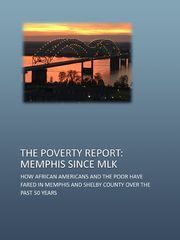It’s time for white America – and white Memphis and Shelby County – to finally take the unflinching look in the mirror that it has avoided for so long.
It is time to admit that we have been lying to people of color since before the ink on the Declaration of Independence was dry, and the 50 years since Dr. Martin Luther King was killed only attest to that fact.
That said, we never expected that we would have to confess that the last 50 years were a classic bait and switch.
That was the conclusion we drew from “The Poverty Report: Memphis Since MLK,” a seminal report by Dr. Elena Delavega, associate professor in the University of Memphis Department of Social work and staff member of the Benjamin Hooks Institute for Social Change about poverty in Memphis since 1968. There have been other reports about poverty in recent years that have been flares calling for our attention, but this report is the equivalent of a blast furnace.
Stuck In Time
It laid bare the deception that was committed when we assured African Americans that the key to opening the door to prosperity was all about getting an education. They did, in record numbers, but after 50 years of dramatic success in increasing the percentage of African Americans with high school degrees and college degrees, the disparity in median incomes between African Americans and whites remain the same.
The gap: whites’ median household incomes are still twice African Americans. Dr. Delavega said that if Memphis selects one statistic to measure success, it is the income of African Americans.
It is hard to think of a statistic that more indicts whites for the glib bromides we offered up to African Americans – like pulling themselves up by their own bootstraps – while institutional racism remained in place and while many programs, such as warehousing poor black families in public housing, were siloed in a system where their maximum positive impact was always limited.
After all, these bromides masquerading as solutions obscured answers that were staring us in the face, such as reforming our low-wage economy and the incentive program that shifts more of the tax burden onto the poor, linking programs so all aspects of the challenges facing a family can be addressed in a systematic and individual way, reforming our criminal justice system and its mass incarceration of people of color, fighting for safety net programs now being shredded by the president and Congress, and honestly admitting the reality impact of institutional racism and white privilege.
A Lead Ceiling
This is not to say that higher educational attainment did not benefit African Americans, but it does say that the ultimate solutions to poverty are multi-dimensional and found in cross-discipline approaches.
Even as some African Americans moved into jobs previously out of reach 50 years ago, the poverty report demonstrated that advancement is still limited by a ceiling that is more lead than glass and that crime-fighting policies disproportionately directed at African Americans deplete the human capital potential of this community.
We have to admit that the elements of the poverty report were not surprising. What was surprising was the disturbing lack of progress in leveling the playing field in such a way that the income gap has been reduced.
After all, we’ve talked about the price we pay as a community for the intransigent problem of poverty for decades, and if we needed a motivator for action, it should have come in 1968 with Dr. King’s campaign for equality and economic justice and the issuance of the Kerner Report (National Advisory Commission on Civil Disorders) five weeks before Dr. King’s death. The Kerner Report said it plainly, “Our nation is moving toward two societies, one black, one white—separate and unequal,” and laid the cause at the feet of racism which blocks programs to eliminate segregation and limit opportunity.
There’s Simply No Excuse
Commissioned by the National Civil Rights Museum as part of its MLK50 commemoration (whose calendar demonstrates its maturity as a powerful Memphis institution), the 27-page report compellingly lays out the dimensions of the hurdles facing the Memphis region if it harbors hope of achieving the lofty ambitions we often assign to ourselves. Absent progress on the issues contained in the report, our community is running at half-speed with half of the community – those in poverty and those who are living at risk – denied a path to the economic mainstream because of structural barriers.
Here’s the thing: the data we are citing from the report is for Shelby County, which means that the data are even more disturbing if they were for the city of Memphis. Here are key points made by Professor Delavega’s research that everyone who cares about the future of Memphis and Shelby County should know:
* The current child poverty rate for African Americans is 48.3% and that is higher than it was in 1980 when it was 45.2%, the first year this data was collected by the U.S. Census Bureau. By 2000, the child poverty rate had dropped to 34.5% – still a disturbing level but it has climbed by about 40% since then. During the same period, the overall African American poverty rate fell modestly from 36.5% to 29.2%.
“It is interesting to note that poverty among African Americans declined the second part of the 20th century, post the Civil Rights Movement, but has increased in the new millennium,” wrote Dr. Delavega. “As always, women and children suffer the worst rates of poverty, and African American children bear the brunt of poverty.”
A Harsh 21st Century
* African Americans have made impressive gains in educational attainment since Dr. King marched in Memphis, increasing from 15.5% of African Americans with high school degrees then to 85.5% now while the percentage of African Americans earning bachelor’s degrees or higher climbed from 4% to 19.6%.
Dr. Delavega wrote: “While the completion of a bachelor’s degree seems to have a greater impact on the reduction of poverty in recent years, from 1970 to 2000, it was the increase in high school completion of African Americans that was associated in poverty. However, this relationship was not sustained in the 21st century when a bachelor’s degree appears to be more important in reducing poverty.”
* African Americans have gained access to better paying jobs. Upon Dr. King’s death, 79% had blue collar jobs and 20.9% had white collar jobs, and today, that is respectively 47.5% and 52.5%. The gap between the number of African Americans with white collar jobs and whites is 40%.
“It is important to note that a white collar job in the economy of the 21st century may not be as meaningful as a white collar job at the beginning of the 20th century,” Dr. Delavega wrote in her report. “Even though there has been a 650% increase in African American participation in white collar jobs, income for African Americans remains stubbornly at about 50% of whites in Shelby County.”
We’re Stuck
* Despite increasing the percentage of African Americans in managerial and professional occupations from 9.1% at the time of Dr. King to 26.7% today, there is question of whether the uptick will increase income.
At the time of the mythical Memphis Jobs Conference in 1981, it was said that a damaging drag on Memphis’ economic potential was the impact of the disparity between white and African American median incomes, which were 2:1. And yet, despite the commitment to education and all the hard work to remove families from poverty, nothing has changed for African Americans: they still make half of whites.
Back then, the median income of an African American household was $9,343, compared to $19,165 for white households. Today, almost 40 years later, African American household incomes of $35,664 and white household incomes $69,860.
* The gap becomes even more stark with per capita incomes – $19,421 for African Americans and $41,135 for whites.
$22 Billion Opportunity
* The percentage of African American men not in the labor force has increased since 1970 when it was 32.3%. Today, it is 35.6%. (The percentage of whites not in the labor force has increased from 18.6% in 1980 to 27.7% today.)
“It is difficult to assign an exact cause, but it is probable that this is the result of the War on Drugs,” wrote Dr. Delavega. As we have blogged previously, our community has one of the highest incarceration rates in the U.S. as a result of the “lock ‘em up” approach to law enforcement.
Following the presentation by Dr. Delavega at the National Civil Rights Museum, which commissioned her report, a panel convincingly and passionately spoke to the stakes for our community if nothing is done to equalize opportunity and prosperity.
That can’t be overstated and said loud enough. As we have blogged often, the economic benefit to our region if we can close the income gap in incomes between whites and people of color would have a $22 billion – with a b – impact on our gross domestic product.
There is no economic development priority that has such potential for our underperforming economy, and that’s not even mentioning the moral imperative in ensuring that every person has a level playing field in front of them when it comes to their careers. As long as Memphis is content to fire on only half of its cylinders, there is no question that the economy will continue to sputter.
The Memphis Mandate
After all, income equity in African American means that higher income puts more money into everyone’s cash registers, more human capital to compete for new jobs, an expanded and more successful economy attracts more attention from major economic development projects, lower costs for incarceration and more money to invest in interventions for children, and so much more.
That said, the United States itself has nothing to brag about when it comes to African American median household incomes, which is $40,000 compared to white incomes of $65,000. As bad as that is, with African Americans earning 62% of whites it better than Shelby County’s 50%.
In a region of more than one million people with the highest percentage of African Americans, the failure to set the closing of the racial income disparity as a top priority for this community is the equivalent of civic malpractice.
No community has greater reason to do this. It is a clear act of self-confidence, self-interest, and self-preservation.
This is one time we must set aside our traditional lack of self-worth and pessimism about our ability to change things and to reimagine that we can be the place that teaches lessons to the rest of the nation. But first, we have to drive a stake in the ground and say that every segment of our community – public, private, nonprofit, grassroots groups, and philanthropic – will take single-minded action to fight income disparity.
It takes a clear agenda and interlocking strategies. The question now is who will take responsibility for convening and driving the process that makes it happen.
***
Join us at the Smart City Memphis Facebook page for daily articles, reports, and commentaries relevant to Memphis.






Let’s be honest. No person, institution, government agency, or even a miracle, is going to make a small dent in our vast income disparity and poverty, especially in a city as polarized as Memphis. Poverty is just part of the Memphis DNA. There have been numerous attempts to change this, but each time Memphis backward leadership made the wrong bet. As a result, it’s impossible to be optimistic about the future. 50 years from now, the same problems will be here, only they will be much worse.
I wa particularly heartened bt the statement that we need to link the programs that are designed to help lift people out of poverty to address all the challenges that keep a family in poverty. You have to address the whole picture. Housing, jobs, food, health care, transportation–it’s all inter-related. The transit system is so poor that most people need a car to get to work. Cars and car repairs are expensive and take money that is needed for food, medicine, housing. Good low-cost housing is scarce and utilities are expensive. Get behind in any of these and you’re in a hole you may not be able to get out of. I’m encouraged that attention is being paid to the need to address all parts of the problem holistically.
Whereto start? Fixing our transit system and the the PILOT programbto require the provision of better-paying jobs would be good goals. Then app I
I was heartened by the statement that we need to link the programs that are designed to help lift people out of poverty to address all the challenges that keep a family in poverty. You have to address the whole picture. Housing, jobs, food, health care, transportation–it’s all inter-related. The transit system is so poor that most people need a car to get to work. Cars and car repairs are expensive and take money that is needed for food, medicine, housing. Good low-cost housing is scarce and utilities are expensive. Get behind in any of these and you’re in a hole you may not be able to get out of. I’m encouraged that attention is being paid to the need to address all parts of the problem holistically.
In far too many measures, the Memphis of 2018 is much worse than the Memphis of 1968.
Change the PILOT program to only reward better paying jobs….OK, make it so, done! PILOT’s now only granted for jobs with a median wage of $75,000+. Now what?
We’ve written about this many times and how to shift the emphasis from entitlement to smart investment based on wise public policy, so we won’t go deep into it again here. But it’s about creating a system that doesn’t exist now that links strategies like those mentioned in this post. Why grant PILOTs to companies and shift the tax burden onto poor Memphians and small business if the employees don’t make a living wage and which result in companies essentially subsidizing them with health care and social services?
Who wrote this? It’s a wonderful article. I’d like to quote it and would like to give credit.